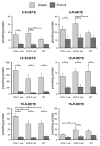Effect of fish oil on levels of R- and S-enantiomers of 5-, 12-, and 15-hydroxyeicosatetraenoic acids in mouse colonic mucosa
- PMID: 22149144
- PMCID: PMC3410550
- DOI: 10.1080/01635581.2012.630168
Effect of fish oil on levels of R- and S-enantiomers of 5-, 12-, and 15-hydroxyeicosatetraenoic acids in mouse colonic mucosa
Abstract
The balance of putative pro- and antiinflammatory lipoxygenase (LOX)-derived S-hydroxyeicosatetraenoic acids (S-HETEs) in colon mucosa is a potential target for modulating colon cancer risk and progression. The biological effects of S-HETEs and R-hydroxyeicosatetraenoic acids (produced by distinct pathways) may differ, but levels of these compounds in the colon are unknown. The objective of this study was to develop chiral methods to characterize hydroxyeicosatetraenoic (HETE) enantiomers in colonic mucosa and evaluate the effects of fish oil on HETE formation. C57BL/6 mice (COX-1 null, COX-2 null, wild-type) were fed a diet supplemented with either olive oil or menhaden oil for 11 wk, and R-/S-HETEs in colonic mucosa were quantified by chiral LC-MS/MS. The R-enantiomer comprised 60-72% of 5-HETE, 18-58% of 15-HETE, and 1-16% of 12-HETE in colonic mucosa, suggesting that non-LOX sources contribute to HETE profiles. Fish oil reduced levels of both R- and S-HETEs, and increased the preponderance of the R-enantiomers (particularly 12- and 15-HETEs). There was apparent shunting of arachidonic acid to 12-/15-LOX in the COX-1 null animals. This is the first report of the enantiomeric composition of HETEs in the colon in vivo and shows large effects of fish oil in the normal colon.
Figures



Similar articles
-
Effect of cyclooxygenase genotype and dietary fish oil on colonic eicosanoids in mice.J Nutr Biochem. 2012 Aug;23(8):966-76. doi: 10.1016/j.jnutbio.2011.05.003. Epub 2011 Sep 19. J Nutr Biochem. 2012. PMID: 21937210 Free PMC article.
-
Biosynthesis of 12(S)-hydroxyeicosatetraenoic acid by B16 amelanotic melanoma cells is a determinant of their metastatic potential.Lab Invest. 1994 Mar;70(3):314-23. Lab Invest. 1994. PMID: 8145526
-
Mono (S) hydroxy fatty acids: novel ligands for cytosolic actin.J Lipid Res. 1998 Jul;39(7):1476-82. J Lipid Res. 1998. PMID: 9684751
-
Biosynthesis, biological effects, and receptors of hydroxyeicosatetraenoic acids (HETEs) and oxoeicosatetraenoic acids (oxo-ETEs) derived from arachidonic acid.Biochim Biophys Acta. 2015 Apr;1851(4):340-55. doi: 10.1016/j.bbalip.2014.10.008. Epub 2014 Oct 29. Biochim Biophys Acta. 2015. PMID: 25449650 Free PMC article. Review.
-
The Role of Hydroxyeicosatetraenoic Acids in the Regulation of Inflammation in Bronchial Asthma.Dokl Biochem Biophys. 2024 Dec;519(1):512-520. doi: 10.1134/S1607672924701126. Epub 2024 Sep 16. Dokl Biochem Biophys. 2024. PMID: 39283556 Review.
Cited by
-
The Quantitative Profiling of Oxylipins from Arachidonic Acid by LC-MS/MS in Feces at Birth 3 Days and 21 Days of Piglets.Metabolites. 2022 Jul 28;12(8):702. doi: 10.3390/metabo12080702. Metabolites. 2022. PMID: 36005575 Free PMC article.
-
Differential contribution of lipoxygenase isozymes to nigrostriatal vulnerability.Neuroscience. 2013 Jan 3;228:73-82. doi: 10.1016/j.neuroscience.2012.10.009. Epub 2012 Oct 16. Neuroscience. 2013. PMID: 23079635 Free PMC article.
-
Gas chromatography-mass spectrometry analysis of effects of dietary fish oil on total fatty acid composition in mouse skin.Sci Rep. 2017 Feb 14;7:42641. doi: 10.1038/srep42641. Sci Rep. 2017. PMID: 28195161 Free PMC article.
-
Effects of fish oil supplementation on prostaglandins in normal and tumor colon tissue: modulation by the lipogenic phenotype of colon tumors.J Nutr Biochem. 2017 Aug;46:90-99. doi: 10.1016/j.jnutbio.2017.04.013. Epub 2017 Apr 25. J Nutr Biochem. 2017. PMID: 28486173 Free PMC article.
-
Biomarkers for personalizing omega-3 fatty acid dosing.Cancer Prev Res (Phila). 2014 Oct;7(10):1011-22. doi: 10.1158/1940-6207.CAPR-14-0134. Epub 2014 Aug 19. Cancer Prev Res (Phila). 2014. PMID: 25139294 Free PMC article.
References
-
- Chapkin RS, Mcmurray DN, Lupton JR. Colon cancer, fatty acids and anti-inflammatory compounds. Curr Opin Gastroen. 2007;23:48–54. - PubMed
-
- Mclean MH, Murray GI, Fyfe N, Hold GL, Mowat N. a. G., et al. COX-2 expression in sporadic colorectal adenomatous polyps is linked to adenoma characteristics. Histopathology. 2008;52:806–15. - PubMed
-
- Shureiqi I, Wojno KJ, Poore JA, Reddy RG, Moussalli MJ, et al. Decreased 13-S-hydroxyoctadecadienoic acid levels and 15-lipoxygenase-1 expression in human colon cancers. Carcinogenesis. 1999;20:1985–95. - PubMed
Publication types
MeSH terms
Substances
Grants and funding
LinkOut - more resources
Full Text Sources
Research Materials
